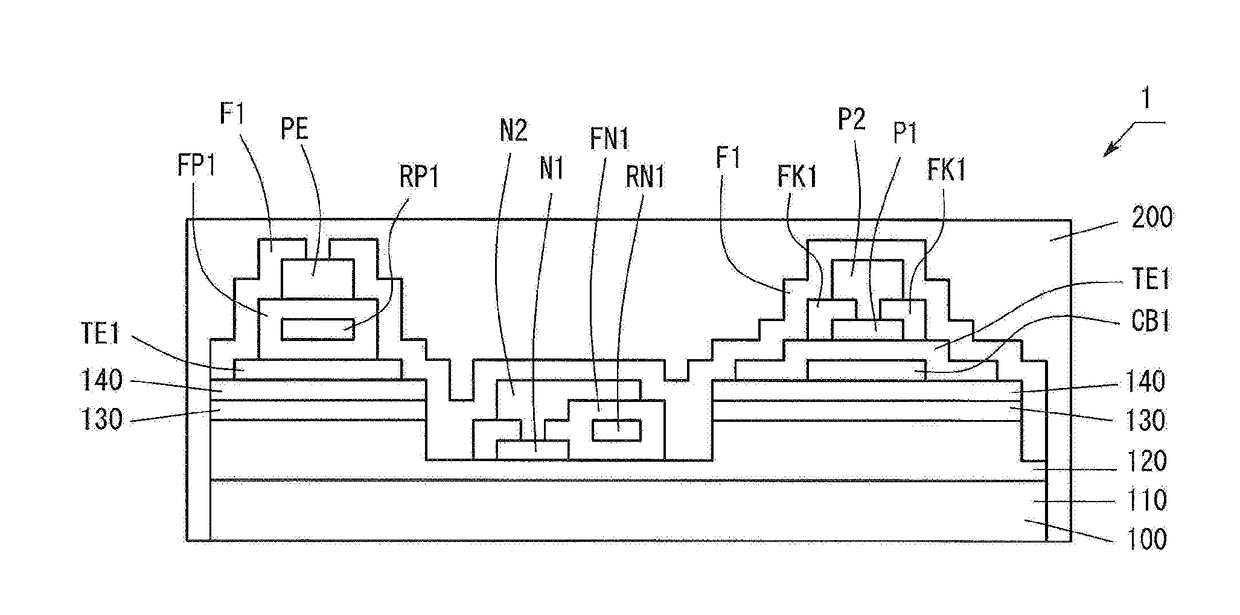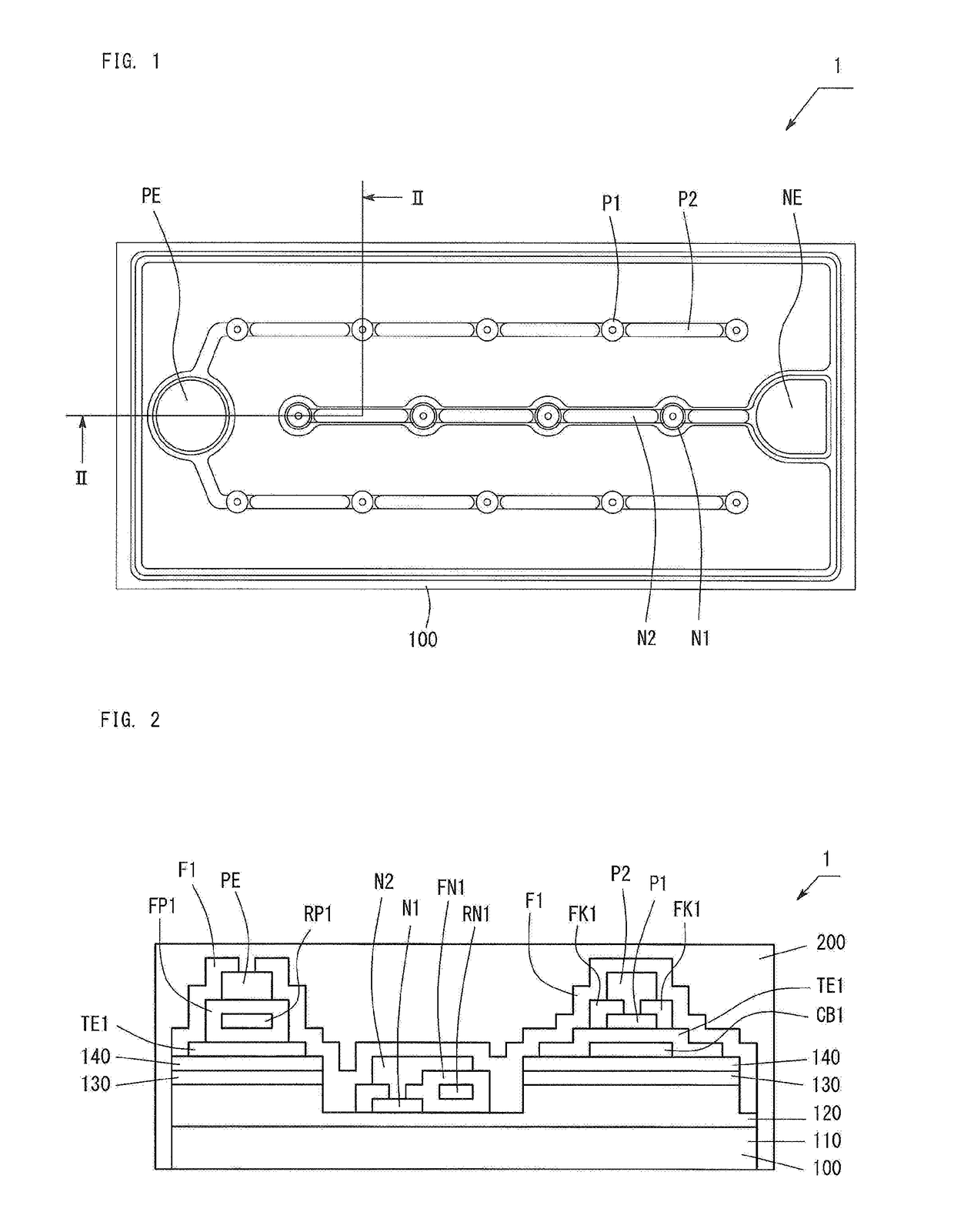Light-emitting device and production method therefor
a technology of light-emitting devices and production methods, which is applied in the direction of semiconductor devices, basic electric elements, electrical apparatus, etc., can solve the problems of reduced light extraction efficiency of conventional light-emitting devices, and the light generated in the light-emitting layer is not completely extracted, so as to facilitate light extraction to the outside and suppress light absorption by electrodes
- Summary
- Abstract
- Description
- Claims
- Application Information
AI Technical Summary
Benefits of technology
Problems solved by technology
Method used
Image
Examples
first embodiment
1. Light-Emitting Device
[0033]FIG. 1 is plan view showing the structure of a light-emitting device 1 according to the first embodiment. FIG. 2 is a cross-section of the light-emitting device 1 shown in FIG. 1, cut along II-II. The light-emitting device 1 has a light-emitting element 100 and a phosphor-containing resin coating 200. The light-emitting device 1 is a Group III nitride semiconductor light-emitting device which emits white light. The light-emitting device 1 provides light having a wavelength of 400 nm to 800 nm. The light-emitting element 100 is a semiconductor light-emitting device of face-up type having a plurality of semiconductor layers formed of a Group III nitride semiconductor.
[0034]As shown in FIGS. 1 and 2, the light-emitting element 100 has a substrate 110, an n-type semiconductor layer 120, a light-emitting layer 130, a p-type semiconductor layer 140, a current-blocking layer CB1, a transparent conductive oxide film TE1, a dielectric film F1, a dielectric film ...
second embodiment
[0082]Second embodiment will be described.
1. Light-Emitting Device
[0083]FIG. 11 is a plan view of the general structure of a light-emitting device 3 of the second embodiment, and FIG. 12 is a cross-section of the light-emitting device 3 shown in FIG. 11, cut along XII-XII. The light-emitting device 3 has a light-emitting element 400 and a phosphor-containing resin coating 200.
[0084]As shown in FIGS. 11 and 12, the light-emitting element 400 has a substrate 110, an n-type semiconductor layer 120, a light-emitting layer 130, a p-type semiconductor layer 140, a current-blocking layer CB1, a transparent conductive oxide film TE1, a dielectric film F2, a dielectric film FN1, a dielectric film FP1, a dielectric film FK1, a reflective film RN1, a reflective film RP1, n-side dot electrodes N1, an n-side wiring electrode N2, an n-side pad electrode NE, p-side dot electrodes P1, a p-side wiring electrode P2, and a p-side pad electrode PE.
2. Relationship Between Stacking Configuration and Refr...
third embodiment
[0088]Third embodiment will be described.
1. Light-Emitting Device
[0089]FIG. 13 is a cross-section of the light-emitting device 4 of the third embodiment. The light-emitting device 4 has a light-emitting element 500 and a phosphor-containing resin coating 200.
[0090]As shown in FIG. 13, the light-emitting element 500 has a substrate 110, an n-type semiconductor layer 120, a light-emitting layer 130, a p-type semiconductor layer 140, a distributed Bragg reflector DBR1, a transparent conductive oxide film TE1, a distributed Bragg reflector DBR2, a distributed Bragg reflector DBR3, a dielectric film F3, n-side dot electrodes N1, an n-side wiring electrode N2, an n-side pad electrode NE, p-side dot electrodes P1, a p-side wiring electrode P2, and a p-side pad electrode PE.
[0091]The distributed Bragg reflectors DBR1, DBR2, and DBR3 serve as films each selectively reflecting light having a wavelength λ. The dielectric film F3 serves as an anti-reflector (AR).
[0092]Thus, when the distributed...
PUM
| Property | Measurement | Unit |
|---|---|---|
| emission wavelength | aaaaa | aaaaa |
| light wavelength | aaaaa | aaaaa |
| light wavelength | aaaaa | aaaaa |
Abstract
Description
Claims
Application Information
 Login to View More
Login to View More - R&D
- Intellectual Property
- Life Sciences
- Materials
- Tech Scout
- Unparalleled Data Quality
- Higher Quality Content
- 60% Fewer Hallucinations
Browse by: Latest US Patents, China's latest patents, Technical Efficacy Thesaurus, Application Domain, Technology Topic, Popular Technical Reports.
© 2025 PatSnap. All rights reserved.Legal|Privacy policy|Modern Slavery Act Transparency Statement|Sitemap|About US| Contact US: help@patsnap.com



